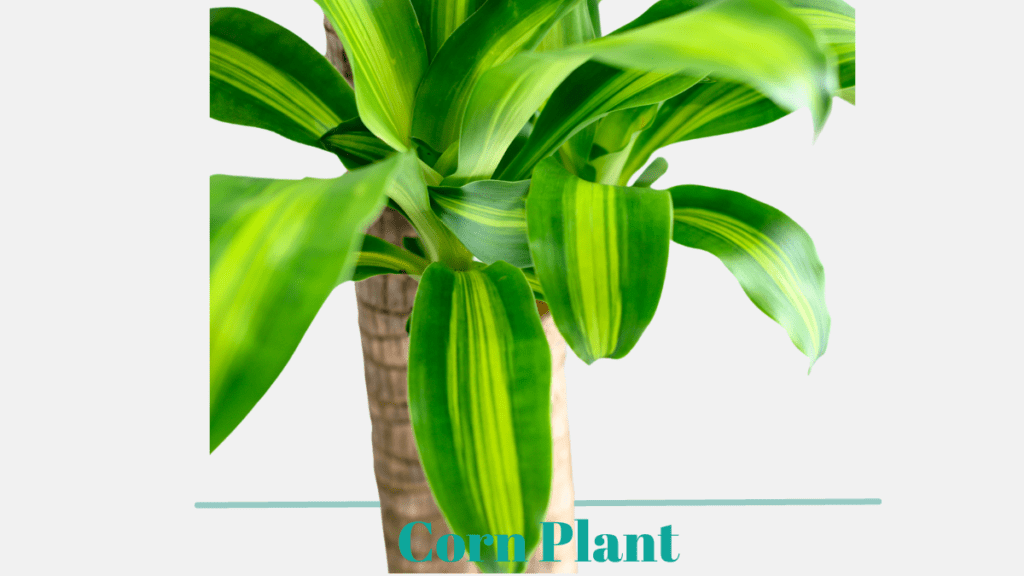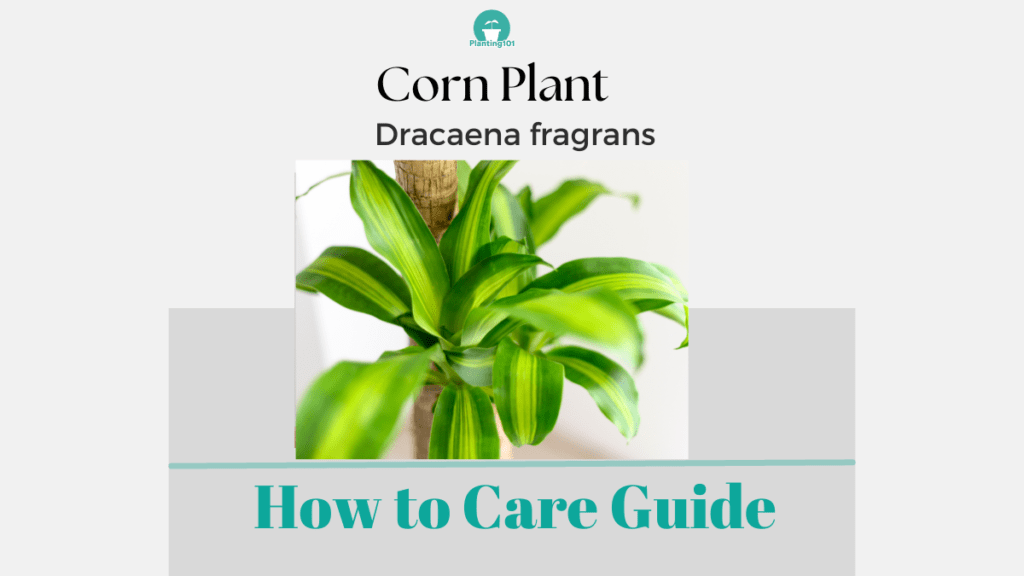Corn Plant (Dracaena fragrans) is the perfect houseplant for beginners (it was my first houseplant!) It is an easy-to-grow houseplant that can tolerate a wide range of conditions including low-light conditions. It is also known to be an air-purifying plant because it is very effective in removing air pollutants from the air. It has attractive glossy leaves reminiscent of corn leaves. Here is a beginner’s guide on how to care for your Corn Plant indoors.

Corn Plant Houseplant Care at a Glance
| Name | Corn Plant |
| Scientific Name | Dracaena fragrans “Massangeana” |
| Care Level | Easy |
| Light | Bright Indirect Light. Can Tolerate Low Light. |
| Daytime Temperature | 65 to 75F (18-24C) |
| Night Time Temperature | 55-65F (13-18C) |
| Water | Moderate Water |
| Humidity | Moderate Humidity |
| Potting | Well-draining, organic, all-purpose potting mix |
| Fertilizer | Apply once during early Spring and apply once in June. |
| Air Purifying Plant | Removes trichloroethylene (TCE), Formaldehyde, and Benzene. |
| Toxic to Pets and Humans | Toxic |
Light
Corn Plant: Sun or Shade?
Corn Plant is happiest in bright, filtered light. Your Corn Plant is not very sensitive to light conditions because it can tolerate low light and full sun. You can place it in a north facing window or a south facing window, although it will not grow as well in low light and intense light. It’s happiest with a half day of sun (east or west windows).
My first corn plant was in front of my north-facing apartment in Manhattan and it grew happily!
Water
How Often Should You Water Your Corn Plant?
Your Corn Plant has moderate water requirements. Water your Corn Plant when the soil feels dry. The best way to tell when it is time to water your Corn Plant is to feel the soil. Stick your finger in the soil 1 inch deep. If it feels dry, it’s time to water your Corn Plant.
I was not the best plant parent back then and neglected to water my corn plant. It still thrived! Corn plants don’t need to be watered frequently- once every 2 to 3 weeks. The best way to tell is to feel the soil!
How Do You Know When to Water Your Corn Plant?
Water your Corn Plant when the soil feels dry. The best way to tell when it’s time to water is by sticking your finger into the soil. Stick your finger in the soil 1 inch deep. If the soil feels dry, then it’s time to water your Corn Plant.
How Do You Make Sure There is Proper Drainage for Your Corn Plant?
Good drainage is important, you don’t want your Corn Plant to sit in soggy soil. Make sure there are drainage holes at the bottom of the pot. After watering your Corn Plant and you see water draining out of the pot’s drainage holes, make sure you empty out the accumulated water in the saucer. Don’t let your Corn Plant’s pot sit in this puddle of water. It will cause root rot!
Do You Need to Mist Your Corn Plant?
Your Corn Plant is a houseplant that grows best in a moderate humid setting. You should increase indoor humidity. Mist your Corn Plant twice a week.
Soil
What Type of Potting Mix is Best for Your Corn Plant?
Your Corn Plant needs a well-draining, organic all-purpose potting mix.
How Do You Know When To Repot Your Corn Plant?
Repot your Corn Plant when it outgrows its current pot. Repot your Corn Plant in a container with a diameter 2 inches larger than the current pot. Your Corn Plant is a slow growing plant so don’t plant it in a container that is too big.
Fertilizer
Do You Need to Fertilize Your Corn Plant?
Your Corn Plant should be fertilized twice a year- once during early Spring and once in June.
What Fertilizer Should You Use on Your Corn Plant?
Use liquid or powder, organic fertilizer with a higher ratio of nitrogen on your Corn Plant.
Common Problems of Corn Plant Care
The most common problems that affect Corn Plant are root rot, brown leaf tips and mealybugs.
Corn Plant Problem: Fluffy White Growth In Between the Leaves and Stems
Problem: There are fluffy white growths in between the leaves and stems of your Corn Plant.
Cause: Mealybugs are causing the fluffy white growth on your Corn Plant. It is a common houseplant disease.
Solution: To get rid of mealybugs on your Corn Plant, wash your plant with water. You can also use soapy water. Spraying rubbing alcohol on affected areas can also get rid of mealybugs. Horticultural oil and insecticidal soap are also effective in getting rid of mealybugs.
Check out our article on how to make your own homemade pesticides using baby shampoo: How to Make Horticultural Oil and How to Make Insecticidal Soap
Corn Plant Problem: Looks Wilted (Soil is Wet)
Problem: Your Corn Plant looks wilted even if the soil is wet. Check for root rot by pulling the plant out and examining the roots. If the roots of your Corn Plant plant look mushy (healthy roots are firm) and the roots are gray to black in color, these are telltale signs of root rot.
Cause: Root rot is caused by fungus and is a serious problem for your Corn Plant. Root rot is a result of wet soil due to overwatering or poor drainage.
Solution: When your Corn Plant is afflicted with root rot the chance of survival is slim. Your best course of action is to throw your Corn Plant out and start over with a new plant. This time don’t overwater your Corn Plant and make sure there is good drainage in the pot.
Corn Plant Problem: Tip of Leaves of Your Corn Plant Turning Brown
Problem: The tips of the leaves of your Corn Plant plant are turning brown.
Cause: When the tips of the leaves of your Corn Plant turn brown that is a result of not enough water or humidity. The tips of the leaves are turning brown because they are dying.
Solution: Water your Corn Plant and increase humidity by watering your Corn Plant. Just make sure to let your Corn Plant completely air dry so it does not suffer from root rot. Another reason for the brown leaf tips is the tap water you use may have too many chemicals. Try watering with distilled water or rainwater to see if that resolves the issue.
Corn Plant: Air Purifying Plant
Corn Plant is an air purifying plant. It will clean the air by removing air pollutants such as trichloroethylene (TCE), Formaldehyde, and Benzene. In a NASA research study, Corn Plant is effective in removing trichloroethylene (TCE), benzene, and formaldehyde. In fact, the NASA research study showed that Corn Plants effectively removed 70% of formaldehyde in the air, 21.4% of benzene in the air, and 12.5% of trichloroethylene in the air.
Cleaning Corn Plant Houseplant
What’s the best way to clean the leaves of your Corn Plant?
Dust accumulates on your Corn Plant leaves over time. The layer of dust decreases the plant’s ability to photosynthesize. Periodically wiping down the leaves of your Corn Plant with a damp cloth will help keep your plant healthy. You can also use a duster or dry duster cloth to wipe off the layer of dust on the leaves. Avoid using leaf-shining chemicals on your Corn Plant, it will clog up the leaf pores.
Corn Plant: Common Names
Corn Plant is also called Cornstalk Dracaena, Dracaena, Corn Cane, and Mass Cane.
Corn Plant: Size
Your Corn Plant is a large houseplant that can grow up to 6 feet tall indoors. It’s a slow-growing houseplant.
Corn Plant: Toxic to Pets?
Corn Plants are toxic to humans and pets. Don’t let children or pets chew on the leaves of the Corn Plant plant because it contains saponins. Saponins have been used as fish poison! It can cause vomiting, nausea, and diarrhea. It will cause dilated pupils in cats. If you see any of these symptoms and suspect ingestion of Corn Plant plants, call poison control immediately! Also, call your doctor or vet once you start seeing adverse reactions in children and pets.
You May Also Be Interested In:
How to Take Care of Haworthia (infograph)

